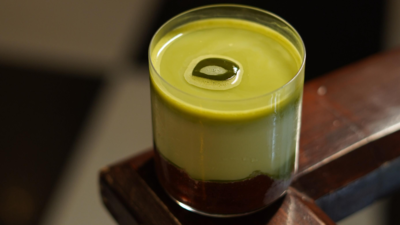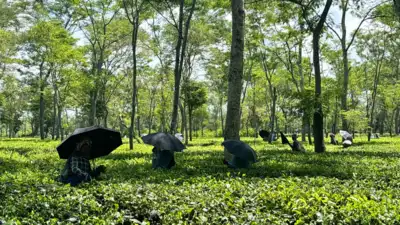ARTICLE AD BOX

Strawberry Matcha at Dou, Nungambakkam
Nirmal Raj, founder of Buddies Café and Dandjo Teas in Ooty, has been selling matcha since 2015. But of late, says the tea merchant, the quantities he has had to procure have more than quadrupled.
“Till a couple of years ago, I used to buy only 500g a month. It’s now 8kg a month and rising,” says Nirmal. He’s not sure what’s driving the surge, but he’s planning to ride the wave with a matcha dessert menu soon. It’s game, set, matcha everywhere. Namratha Marlecha, founder of Sante Spa Cuisine in Chennai, is also seeing an increase in demand for their matcha dishes. “We’ve been around for more than seven years now, and hardly a handful of people used to try our smoothie matcha bowl or matcha pina colada, for the health benefits.
Today, almost every table has someone ordering matcha dishes. The demand has pushed us to rework our menu and add more matcha drinks,” says Namratha.

Strawberry Matcha at Dou, Nungambakkam
A finely ground powder made from specially grown and processed green tea leaves, matcha involves consuming the entire powdered young leaf, offering a more concentrated dose of nutrients and antioxidants, unlike regular green tea, where you steep the leaves. Once a niche Japanese import, matcha is now riding the social media wave into cafés, kitchens, and even personal tea collections across Chennai.
Latshyamitra R says every time she opens her Instagram account, her feed is filled with matcha tea recipes. So much so that the UX designer got curious, bought 30g of ceremonial-grade matcha online, a premium quality powder traditionally used in the Japanese tea ceremony, for Rs 800. “I made matcha drinks with caramel, strawberry and vanilla,” says Latsyamitra. “I’m planning to bake next,” she says. Saravanan B V, a brand designer from Ooty, initially tried it for its high antioxidant properties and health benefits.
But soon he fell in love with the taste and now collects matcha varieties. Not all matcha tastes the same, says Saravanan. Indian matcha has an astringent taste (a dry, puckering sensation in the mouth) that comes from the altitude difference and the way it is ground, compared to Japanese matcha. The Japanese matcha, says Alexander R K, chef at Dou, Nungambakkam, has a unique flavour profile; a delicate balance of earthiness, umami and subtle bitterness making it a versatile ingredient that blends well with sweet and savoury dishes. “We are trying to use matcha as salt in barbecue meats and tempura,” says Alexander. “They are still in a trial phase, but show promise among adventurous diners. We’re also exploring matcha-infused sauces and glazes that can complement Asian-inspired small plates and grills,” he adds.

Matcha Brownie
Café owners and tea merchants say they procure their matcha from Japan or Assam (the only place in India where it is grown). Chota Tingrai in Assam’s Tinsukia district is the only tea estate in the country that produces it. “We’ve been making green tea at Chota Tingrai using Japanese technology since the 1980s, but matcha requires far greater precision and investment,” says tea manufacturer Mrigendra Jalan of Jalan Industries. The estate is experimenting with the Yabukita cultivar and its Assam equivalent, slowly moving toward Japanese standards with both ceremonial and culinary grades. “The process is slow and costly, as one Japanese grinding machine costs Rs 40 lakh and produces just 10kg a day,” he says. South India has the potential to grow matcha, says Jalan, but the climate and altitude will influence its flavour profile. “South Indian tea is not as strong as Assam tea, and less bitter. While Assam works on refining production, demand from Chennai, Bengaluru, and Ooty is already surging, pointing to a future where locally grown matcha could complement imports from Japan.”
GRADE GUIDE
Ceremonial grade
A premium quality matcha powder, traditionally used in the Japanese tea ceremony, characterised by its smooth, delicate, and subtly sweet flavour
Premium grade
A blend of first and second harvests, offering a slightly bolder, more robust flavour, suitable for both drinking straight and for use in lattes and other recipes
Culinary grade
A lower grade intended for use in lattes, smoothies, and baked goods
Something is brewing
The catechins in matcha help improve cardiac health and metabolic balance. “It’s also a good source of potassium which improves blood pressure and is rich in Vitamin K, an important fat-soluble vitamin required for blood clotting and bone health (especially in post-menopausal women),” says Meenakshi Bajaj, dietician at Tamil Nadu Govt Multi Super Specialty Hospital. Matcha has more caffeine than regular green tea (70mg per 2g serving) but less than coffee (120mg per cup).
Those with fluid, potassium and vitamin K restrictions in their diet must avoid matcha. Avoid matcha in the late afternoon or evening as it may disturb sleep. For those on iron supplements, matcha can be had 1-2 hours before or after



.png)
.png)
.png)
















 8 hours ago
5
8 hours ago
5










 English (US) ·
English (US) ·